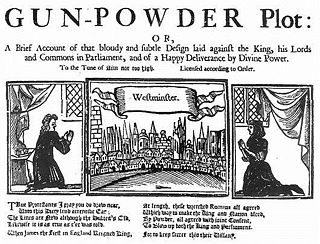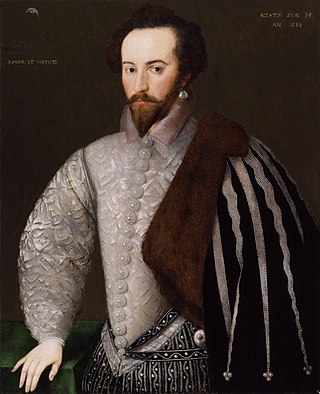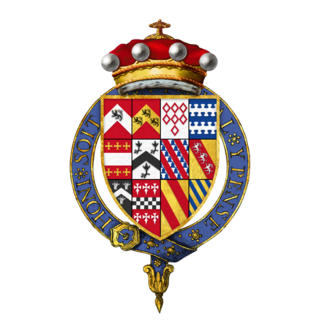
Guy Fawkes, also known as Guido Fawkes while fighting for the Spanish, was a member of a group of provincial English Catholics involved in the failed Gunpowder Plot of 1605. He was born and educated in York; his father died when Fawkes was eight years old, after which his mother married a recusant Catholic.

The Gunpowder Plot of 1605, in earlier centuries often called the Gunpowder Treason Plot or the Jesuit Treason, was an unsuccessful attempted regicide against King James I by a group of English Catholics led by Robert Catesby who considered their actions attempted tyrannicide and who sought regime change in England after decades of religious persecution.

Sir Walter Raleigh was an English statesman, soldier, writer and explorer. One of the most notable figures of the Elizabethan era, he played a leading part in English colonisation of North America, suppressed rebellion in Ireland, helped defend England against the Spanish Armada and held political positions under Elizabeth I.

Robert Cecil, 1st Earl of Salisbury, was an English statesman noted for his direction of the government during the Union of the Crowns, as Tudor England gave way to Stuart rule (1603). Lord Salisbury served as the Secretary of State of England (1596–1612) and Lord High Treasurer (1608–1612), succeeding his father as Queen Elizabeth I's Lord Privy Seal and remaining in power during the first nine years of King James I's reign until his own death.

Baron Burgh is a title that has been created twice in the Peerage of England.

Henry Garnet, sometimes Henry Garnett, was an English Jesuit priest executed for high treason, based solely on having had advanced knowledge of the 1605 Gunpowder Plot and having refused to violate the Seal of the Confessional by notifying the authorities. Born in Heanor, Derbyshire, he was educated in Nottingham and later at Winchester College before he moved to London in 1571 to work for a publisher. There he professed an interest in legal studies and in 1575, he travelled to the continent and joined the Society of Jesus. He was ordained in Rome some time around 1582.
William Watson was an English Roman Catholic priest and conspirator, executed for treason.
Francis Tresham, eldest son of Thomas Tresham and Muriel Throckmorton, was a member of the group of English provincial Catholics who planned the failed Gunpowder Plot of 1605, a conspiracy to assassinate King James I of England.
The Bye Plot of 1603 was a conspiracy, by Roman Catholic priests and Puritans aiming at tolerance for their respective denominations, to kidnap the new English King, James I of England. It is referred to as the "bye" plot, because at the time it was presented as a minor component of a larger plot.

Henry Percy, 9th Earl of Northumberland, KG was an English nobleman. He was a grandee and one of the wealthiest peers of the court of Elizabeth I. Under James I, Northumberland was a long-term prisoner in the Tower of London, due to the suspicion that he was complicit in the Gunpowder Plot. He is known for the circles he moved in as well as for his own achievements. He acquired the sobriquet The Wizard Earl, from his scientific and alchemical experiments, his passion for cartography, and his large library.

Henry Brooke, 11th Baron Cobham KG (22 November 1564 – 24 January 1618 /3 February 1618, lord of the Manor of Cobham, Kent, was an English peer who was implicated in the Main Plot against the rule of James I of England.

Robert Wintour and Thomas Wintour, also spelt Winter, were members of the Gunpowder Plot, a failed conspiracy to assassinate King James I. Brothers, they were related to other conspirators, such as their cousin, Robert Catesby, and a half-brother, John Wintour, also joined them following the plot's failure. Thomas was an intelligent and educated man, fluent in several languages and trained as a lawyer, but chose instead to become a soldier, fighting for England in the Low Countries, France, and possibly in Central Europe. By 1600, however, he changed his mind and became a fervent Catholic. On several occasions he travelled to the continent and entreated Spain on behalf of England's oppressed Catholics, and suggested that with Spanish support a Catholic rebellion was likely.

Thomas Percy was a member of the group of provincial English Catholics who planned the failed Gunpowder Plot of 1605. A tall, physically impressive man, little is known of his early life beyond his matriculation in 1579 at the University of Cambridge, and his marriage in 1591 to Martha Wright. In 1596 his second cousin once removed, Henry Percy, 9th Earl of Northumberland, appointed him constable of Alnwick Castle and made him responsible for the Percy family's northern estates. He served the earl in the Low Countries in about 1600–1601, and in the years before 1603 was his intermediary in a series of confidential communications with King James VI of Scotland.

Sir William Wade was an English statesman and diplomat, and Lieutenant of the Tower of London.
The Rev. George Brooke was an English aristocrat, executed for his part in two plots against the government of King James I.

Anne Brooke, Baroness Cobham was the wife of Sir George Brooke, 9th Baron Cobham. She was the attendant horsewoman at Anne Boleyn's coronation as Queen Consort on 1 June 1533, and she was allegedly one of the first accusers of Queen Anne in 1536. Anne Braye was Baroness Cobham from 1529 until her death in 1558.
Thomas Grey, 15th Baron Grey de Wilton was an English aristocrat, soldier and conspirator. He was convicted of involvement in the Bye Plot against James I of England.
Thomas Brooke (1533-1578), of Wandsworth, Surrey, was an English nobleman, privateer, conspirator, and briefly a member of parliament.

Frances Howard, Countess of Kildare, was a courtier and governess of Princess Elizabeth Stuart, Queen of Bohemia, and a member of the House of Howard.












